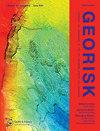Data-driven subsurface modelling using a Markov random field model
IF 4.8
3区 工程技术
Q1 ENGINEERING, GEOLOGICAL
Georisk-Assessment and Management of Risk for Engineered Systems and Geohazards
Pub Date : 2023-01-02
DOI:10.1080/17499518.2023.2181973
引用次数: 5
Abstract
ABSTRACT This paper presents a method of subsurface modelling based on a Markov random field (MRF) model called Potts model. Potts model is an undirected graphical model and has been applied in image processing such as image denoising, restoration and inpainting. The proposed method is simple and requires only a few borehole data on soil types in both training and inference stages. Current implementations of the Potts model require substantial data for training, and they are not suitable for subsurface modelling. The proposed method was demonstrated through numerical examples for 2D and 3D virtual grounds and a real case history. In the numerical examples, the effect of the number of training datasets on the estimation results was also investigated. The proposed method can provide not only the most probable inference of subsurface model but also the spatial distribution of geological uncertainty and is compatible with reliability-based analysis in geotechnical engineering. The spatial distribution of uncertainty is informative in its own right. It directs the engineer to focus on mechanically important zones where the critical failure mechanism passes through if they coincide with the low-accuracy zones.使用马尔可夫随机场模型的数据驱动地下建模
摘要本文提出了一种基于马尔可夫随机场(MRF)模型的地下建模方法,称为Potts模型。Potts模型是一种无向图形模型,已被应用于图像处理,如图像去噪、恢复和修复。所提出的方法很简单,在训练和推理阶段只需要少量的土壤类型钻孔数据。Potts模型的当前实现需要大量数据进行训练,并且它们不适合地下建模。通过二维和三维虚拟场地的数值算例以及真实的案例历史证明了所提出的方法。在数值算例中,还研究了训练数据集数量对估计结果的影响。所提出的方法不仅可以提供地下模型的最可能推断,还可以提供地质不确定性的空间分布,并且与岩土工程中基于可靠性的分析相兼容。不确定性的空间分布本身就具有信息性。它指示工程师将重点放在机械上重要的区域,如果这些区域与低精度区域重合,则关键故障机制会通过这些区域。
本文章由计算机程序翻译,如有差异,请以英文原文为准。
求助全文
约1分钟内获得全文
求助全文
来源期刊
CiteScore
8.70
自引率
10.40%
发文量
31
期刊介绍:
Georisk covers many diversified but interlinked areas of active research and practice, such as geohazards (earthquakes, landslides, avalanches, rockfalls, tsunamis, etc.), safety of engineered systems (dams, buildings, offshore structures, lifelines, etc.), environmental risk, seismic risk, reliability-based design and code calibration, geostatistics, decision analyses, structural reliability, maintenance and life cycle performance, risk and vulnerability, hazard mapping, loss assessment (economic, social, environmental, etc.), GIS databases, remote sensing, and many other related disciplines. The underlying theme is that uncertainties associated with geomaterials (soils, rocks), geologic processes, and possible subsequent treatments, are usually large and complex and these uncertainties play an indispensable role in the risk assessment and management of engineered and natural systems. Significant theoretical and practical challenges remain on quantifying these uncertainties and developing defensible risk management methodologies that are acceptable to decision makers and stakeholders. Many opportunities to leverage on the rapid advancement in Bayesian analysis, machine learning, artificial intelligence, and other data-driven methods also exist, which can greatly enhance our decision-making abilities. The basic goal of this international peer-reviewed journal is to provide a multi-disciplinary scientific forum for cross fertilization of ideas between interested parties working on various aspects of georisk to advance the state-of-the-art and the state-of-the-practice.

 求助内容:
求助内容: 应助结果提醒方式:
应助结果提醒方式:


